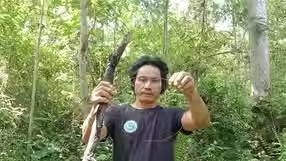
HUMAN-WILDLIFE
CONFLICT
When elephants raid crops or tigers wander too close, the stakes are high for both people and wildlife.
Sumatran Rangers respond with practical, community-driven solutions to prevent conflict and protect species and livelihoods.
LIVING WITH WILDLIFE.
On the edge of the Leuser Ecosystem, people and wildlife live side by side, and many of the forest-edge communities we support experience conflict with critically endangered species such as Sumatran elephants, orangutans and tigers.
Our rangers work to reduce conflict, protect livelihoods, and keep endangered species safe—ensuring a future where both can thrive.
Human-wildlife conflict (HWC) occurs when encounters between people and wildlife lead to negative experiences such as destruction of crops, livestock, property and even loss of life.
HWC events are becoming more frequent worldwide due to encroachment of habitat, population expansion and agricultural development. Retaliatory attacks on wildlife are common in reprisal for negative impacts to livelihoods, and fear.
Sumatran Elephants
Sumatran elephants have lost over 70% of their habitat and half their population in one generation, forcing them into smaller fragments of forest and into conflict and competition with humans.
Elephants in Southeast Asia frequently crop-raid and are often poisoned or shot in retaliation. We work with elephant conflict specialists, to assess our most affected communities and provide for the mitigation and ultimately prevention of further human-elephant conflict, keeping both elephants and people safe.
Our rangers frequently support land owners by safely driving elephants back into the forest from community land. They also provide non-lethal deterrents to discourage elephants coming into the community, helping to avoid damage to crops and dwellings.
More recently, the team have been involved in data collection to assist the Sumatran Elephant Project with a population census of elephants in North Sumatra. Very little is known about this species here and Sumatran Ranger Project regularly monitors a relic herd that we are happy to report is breeding.
SRP regularly responds to requests for assistance from forest edge communities to move elephants away from their gardens and plantations. We use drones, motorbikes and foot patrols to detect elephants and move them safely away from communities with noise deterrents.
Sumatran Orangutans are critically endangered and among one of the most endangered primates in the world.
Around 90% of all remaining Sumatran orangutans live in the Leuser Ecosystem and they are under threat of extinction with the current rate of habitat loss. Sumatran orangutans are almost exclusively arboreal, or tree dwelling, and need large rainforest trees for locomotion, food and sleeping sites.
Because they are not a social species and learn through observation, they need to spend a minimum of seven years with their mother before they have the necessary skills to survive on their own, and they only have one offspring at a time every eight to nine years, so their populations are naturally slow growing.
Sumatran orangutans are threatened by habitat loss and fragmentation, particularly from large scale plantations, mainly oil palm. They love eating fruit, and seek out one of their favourite fruits, durian, during the fruiting season, but durian is a lucrative crop for many locals.
Orangutans will come out of the forest into durian trees planted close to the border, to consume the fruit, which can cause a significant income loss to local people. Our team is working closely to support affected communities along the forest edge and keep orangutans safe from retaliatory harm.
We use noise deterrents to drive orangutans safely back to the forest, and guard them in trees to prevent them being harmed. We also work with local authorities to translocate orangutans where noise deterrents fail and crop raiding puts them at risk of retaliatory harm.
Sumatran Orangutans
Sumatran Tigers
Sumatran tigers are critically endangered.
One of their last strongholds is the Leuser Ecosystem where they can find themselves in close contact with forest edge communities that have settled up against the forest border.
Almost all of these communities graze livestock for income. Typically, livestock are grazed freely overnight in the oil palm plantations that border the National Park and it's an easy meal for an ambush hunter like a tiger, coming straight out of the forest.
Retaliation can be in the form of setting snares, shooting or poisoning and so the Sumatran Ranger Project responds to every sighting or evidence of a tiger or livestock loss to tigers.
In order to find a long-term sustainable solution to the increasing problem of human-tiger conflict in the communities we patrol in, we build predator-proof livestock corrals for communities to enable them to safely house their cows overnight.
We have constructed more than 14 corrals so far, and these have been a successful and cost-effective method to reduce human-tiger conflict in this landscape, keeping both tigers and locals' livelihoods safe.









